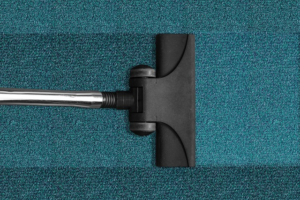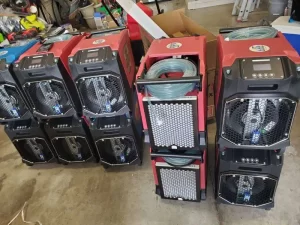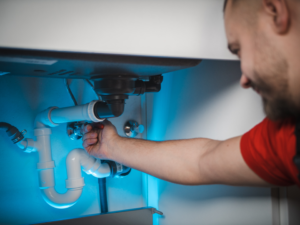Laminate flooring is incredibly convenient, especially if you have kids or pets: it combines the beautiful richness of hardwood with the easy cleaning of tile.
However, it’s vulnerable to water damage like every other flooring. It’s not uncommon for laminate flooring to suffer damage from overflowing washing machines, standing water after a flood, or even occasional spills from a tipped-over drink.
Even a small spill that flows into the cracks between laminate planks can cause serious issues, encouraging mold growth and requiring extensive repairs. Fortunately, repairing laminate flooring isn’t too difficult, as you can simply pull up the damaged planks and replace them.
Simple DIY Steps to Repair Laminate Flooring Water Damage

One of the best things about laminate floors is that they are very conducive to DIY installation and repair, especially because getting more requires only a quick trip to the hardware store.
With a bit of elbow grease and a few hours, you can get your water damaged laminate flooring back to its former glory.
Check and Stop Leaks
First things first: it’s essential that you find out the source of the water and get it taken care of right away. Sometimes it will be obvious, like liquid spills from a dropped vase, but other times it might be more insidious, like a leaking pipe or a malfunctioning dishwasher.
If you’re in any doubt about water damage or leaks, please call TN Flood Kings for help. We’re here 24/7, always just a call away!
Clean Up Excess Water
Now, you need to soak up all the extra water so that more won’t seep into the cracks. You want highly absorbent materials like cloth rags or towels; replace them as they get too saturated.
After this, plug in a dehumidifier and aim fans at the damaged areas to disperse as much moisture as possible.
Examine the Affected Area
You need to identify all the damaged boards so that you can estimate how many new laminate planks you’ll need to pick up from the hardware store.
Look for bubbles, warping, discoloration, and loosened joints, then use a sticky note to demarcate the planks that will need to be removed.
When in doubt, it is always best to replace more of the laminate flooring than you think is ruined; consider pulling up the boards adjacent to those you’ve identified to be safe.
You should remove the whole plank when you spot damage to one section because this means that the laminate on top of the board has been compromised. If left untreated, this can encourage mold growth, and you’ll need to replace the entire floor.
Prepare the Tools for Repair
The first and most obvious tool is new laminate floorboards! Head out to the hardware store and find matching laminate planks.
It’s helpful to bring along any extra planks from your existing flooring, but if you don’t have any extra, take a picture of the room and ask one of the friendly flooring professionals if they can help you select the right color.
Unless your new planks are radically different from the current ones, it won’t be very obvious that they don’t match exactly, so don’t worry.
The other tool that’s most important here is a crowbar. A hammer will work in a pinch, but because the angle is so low, it might be difficult to fit the claw between the joints in the laminate flooring.
Other helpful tools include:
- Safety glasses
- Hammer
- Putty knife
- Measuring tape
- Utility knife
- Underlayment material
- Cleaning solvent
- Flooring adhesive (doesn’t always apply; check manufacturer instructions)
When choosing a flooring adhesive and cleaning solvent, it’s important that you choose something labeled as safe for laminate floors.
Remove Damaged Planks
Use a putty knife on the damaged edges to wiggle them loose before you use the crowbar, as you want everything to be as separated as possible.
Gently pry up every board that got wet, and try not to use too much force, as this can cause further damage. Cut away any underlayment material, as it will also need to be replaced.
Inspect the floorboards below
Now that you’re down to the bare floor, take a close look at the subfloor to identify any signs of mold or water damage.
Damp patches, dark spots, or a musty odor tells you that you’ve got mold growth, and you should contact a water damage company to check the extent of the damage.
If your subfloor looks good and is dry, give it a thorough cleaning, then it’s time to install your new floor!
Install the Replacement Planks
First, you want to install the underlayment material, which is generally foam, felt, or cork. This will protect the underlying floor and provide some extra cushion.
If you have interlocking boards, also called “click laminate” or “floating laminate,” then you shouldn’t glue it down, as it’s meant to support itself and have no connection to the subfloor.
Now, you’ll want to click the laminate flooring to place using the locking system, which is usually just interlocking tabs. Go slow and don’t force it, as you can break the slots off and have to get a new board.
When it feels secure, gently tap it into place with the hammer. You need to be careful here, as a direct hit with a heavy object can crack the laminate and you’ll need to replace the damaged board again.
Now, the next step is to take a deep breath and celebrate! You’ve got gorgeous new laminate flooring that will keep your home safe and dry.
Preventing Water Damage to Your Laminate Floor

If you never want to deal with damage to laminate floors again, you have to prevent water damage as much as possible. Here are some helpful tips to keep your new flooring shining bright for years to come:
- Clean up spills immediately, no matter how small
- Do not use water to clean laminate floor, only specially formulated cleaners
- Place mats down under appliances and check them regularly for moisture
- Call a plumber as soon as you suspect leaks
With careful cleaning and regular inspections, laminate floor can last between 15 and 30 years.
Can You Fix Swollen Laminate Flooring?
Unfortunately, any swollen or warped planks need to be replaced, because they have irreversible damage.
Laminate floor is made of pressed wood materials that have been coated with laminate; if the boards are swollen, that means that the wood fibers have water damage, and they can easily become a breeding ground for mildew and bacteria.
Need Help with Laminate Floor Water Damage in Nashville? We’re Here For You
We understand that water damaged laminate floors are stressful to deal with, and we’re happy to assist. We can assess the situation and identify any water damage, then disinfect the area to prevent any mold growth.
If you’re not sure how to fix your laminate floor, don’t hesitate to reach out! We’re here 24/7 and provide free in home estimates for any problem, big or small. Our IICRC certified technicians use cutting-edge water damage restoration technology, and for major water damage, we work directly with your insurance agency for complete peace of mind.








